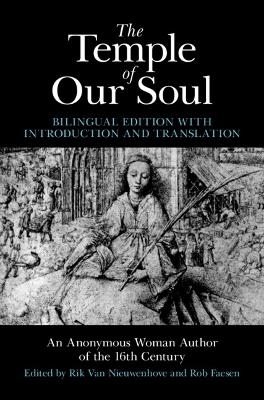
The Temple of Our Soul
Cambridge University Press (Verlag)
978-1-009-29911-4 (ISBN)
The Temple of our Soul is one of the most attractive spiritual texts of the late Middle Ages and early modern period. Written by an anonymous woman, who was also the author of influential The Evangelical Pearl, this masterpiece offers insights into the mystical aspects of Christianity that were widespread in Rhineland and the Low Countries. For political, socio-economic, and geographical reasons, spiritual writings from the Low Countries were highly influential in France, England, and Spain. Language barriers, however, have made the original texts inaccessible to many scholars and students. This bilingual edition offers the first English translation The Temple of our Soul together with the original Dutch text. This edition includes an introduction that provides insights into the text's key themes and the social context in which it was written. In addition to students of medieval mysticism, it will also be of interest to scholars of late medieval and early modern vernacular literature and feminist theology.
Rik van Nieuwenhove is Professor of Medieval Theology at Durham University. He is the author of Introduction to Medieval Theology. 2nd ed. (2022); Thomas Aquinas and Contemplation (2021) and Jan van Ruusbroec. Mystical Theologian of the Trinity (2003). A scholar of spirituality in the medieval Low Countries, Rob Faesen is Professor of Theology and Religious Studies at the Catholic University Leuven, Ruusbroec Institute in Antwerp, and the Tilburg School of Catholic Theology.
Introduction; 1. How God has made the soul his temple, and has adorned it with many graces and gifts; 2. What great crime he does and what severe penalty he deserves who profanes and dishonours this temple through sin; 3. How God laments over this temple and the city of the soul, destroyed in this manner; 4. How God restored the temple of the soul; 5. How God has freed and sanctified the soul for himself; 6. How the soul shall purify herself and exalt her ways before she can enter into this temple; 7. How our mind itself will be the high priest and offer a sacrifice to God; 8. How the exterior liturgy in the holy church is carried out for the sake of the interior liturgy; 9. How we shall spiritually celebrate the solemnity of all saints within ourselves [All Saints]; 10. On the interior advent, and how the soul should prepare itself for the solemnities [Advent I]; 11. On the inner silence of the soul, her harmful running outward and the unification of the senses and the faculties [Advent II]; 12. How the inner soul is chosen by the holy trinity as a spiritual mother of God; how she is turned inward, greeted and made fertile for the divine birth [Advent III]; 13. How God is born in the human person in three ways according to the three unities [Christmas I]; 14. How the heavenly spirits lull the divine birth of the new child with a hymn [Christmas II]; 15. The fruitful virginity of the soul [Christmas III]; 16. How we may carry Christ in our hearts and nourish him [Christmas IV]; 17. How our soul is circumcised spiritually [1 January]; 18. How we, having entered in God with the holy three kings by God's light, must sacrifice ourselves to God and overcome all pride [Epiphany]; 19. On the growth and increase of God's grace in the soul [First Sunday after Epiphany]; 20. With which kind of love Christ has chosen the soul as his bride [Second Sunday after Epiphany]; 21. How we, following the example of Mary, will give birth to Jesus, carry him in us, and make an offering of him at Candlemas; 22. Of three kinds of people and how they practice this birth [Candlemas II]; 23. The dignity of Mary, Mother of God and noble virgin [Candlemas III]; 24. The vineyard of our soul [Septuagesima]; 25. The spiritual field of the soul [Sexagesima]; 26. How those free of mind are taken up [Quinquagesima]; 27. A loving ascent to God [Thursday after Quinquagesima]; 28. How the soul must detach herself in the desert from everything that is not God [First Sunday of Lent I]; 29. How we are being tempted in the desert and how angels administer to us [First Sunday of Lent II]; 30. On the transformation of the soul [Second Sunday of lent]; 31. How the soul is a vineyard of God [Friday after Second Sunday of Lent I]; 32. How Christ Jesus had toiled for that vineyard [Friday after Second Sunday of Lent II]; 33. How he fenced the vineyard and how we will work it [Friday after Second Sunday of Lent III]; 34. How God loved and sought out the chosen soul [Passion tide]; 35. How the groom prepared a suitable home for his bride through his bitter suffering, hard death and precious blood [Maundy Thursday – Good Friday I]; 36. A devout prayer to become equal to the holy life and cross of Jesus [Good Friday II)]; 37. About the spiritual burial of Jesus Christ [Holy Saturday I]; 38. How the interiorly fervent soul shall return to the inner bedroom of her spirit, to prepare the spiritual resurrection [Holy Saturday II]; 39. How we must grow in likeness to the three Marys, to visit and anoint the lord [Easter I]; 40. About the greatest sorrow of Jesus by whose suffering we are saved [Easter II]; 41. About the greatest joy that was in Christ at his joyful resurrection [Easter III]; 42. How the soul rises with Christ, and how God displays and consoles the soul [Easter IV]; 43. How the soul ascends to heaven through Jesus Christ and is introduced into the heaven of t
| Erscheinungsdatum | 04.05.2024 |
|---|---|
| Übersetzer | Rik Van Nieuwenhove, Rob Faesen |
| Zusatzinfo | Worked examples or Exercises |
| Verlagsort | Cambridge |
| Sprache | englisch |
| Themenwelt | Geschichte ► Allgemeine Geschichte ► Mittelalter |
| Geisteswissenschaften ► Geschichte ► Regional- / Ländergeschichte | |
| Geschichte ► Teilgebiete der Geschichte ► Religionsgeschichte | |
| ISBN-10 | 1-009-29911-5 / 1009299115 |
| ISBN-13 | 978-1-009-29911-4 / 9781009299114 |
| Zustand | Neuware |
| Informationen gemäß Produktsicherheitsverordnung (GPSR) | |
| Haben Sie eine Frage zum Produkt? |
aus dem Bereich


